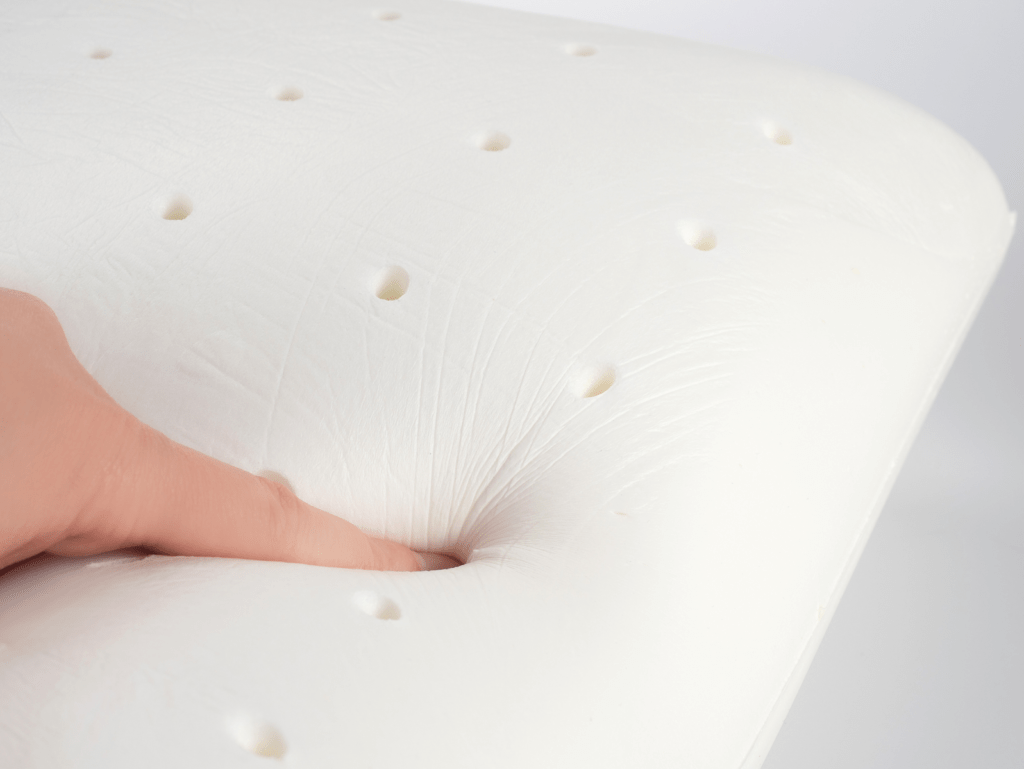Considering we spend about a third of our life in bed, I don’t need to tell you the importance choosing the right pillow. If you’ve woken with a ‘crook’ neck or suffered many sleepless nights tossing and turning, you know too well the importance of the right head and neck support.
And considering the cost of a pillow can range from $20 in the supermarket all the way to $300+, there is a lot of variation out there. Like many things, price isn’t necessarily the best indicator.
So what should you consider when choosing the right pillow?
Firstly, you need to consider…
Your Sleeping Position
Tummy Sleepers
While pressure on our abdomen is very calming for the body and brain (think foetal position) it’s not a great position for the muscles or spine through your neck. Propping your head up on a pillow, turned to the side causes even more strain.

The best pillow for tummy sleepers is no pillow at all.
Back Sleepers
This is a great position for keeping the spine straight and aligned, but not so great for airways. For a lot of people, back sleeping causes breathing issues and snoring. Snoring deprives the brain of oxygen and increases your risk of other conditions such as high blood pressure. But if your airways are open and functioning back sleeping is fine.
The best pillow for back sleepers is something low that doesn’t cause propping up of the head. This can put the head and neck in a similar position to forward head posture when standing.
Side Sleepers

This is the best position for airways and your spinal alignment, if and only if, you have the right pillow. A pillow that supports your neck, head and shoulders enough to keep them aligned.
Get some help to have your pillow checked. Lay on your side as you would sleeping and get that person to look at you from behind:
- Your cervical spine (neck) should be in alignment with the rest of your spine. If it’s curving up, your pillow is too high. If it’s curving down, your pillow is too soft.
- Feel where your shoulder is. If it’s rolling forwards then you don’t have enough support.
- If there is a space between your neck and your pillow, it’s also not right for you.
Everywhere Sleepers
Well, this is a difficult scenario because as you can see, different positions require different pillows. I have searched high and low for a pillow that suits all positions. Because lets be honest, we’re not going to change our pillow every time we change our sleeping position are we? What I have found as the best option for “All over the place sleepers” is something called the Killapilla.
Designed in Australia by a chiropractor, the Killapilla has a “head nest” for back sleeping and a “side support” for side-sleeping. It’s a pretty unique design.
Other things to consider
Mattress and pillow density

Density is basically how firm the mattress or pillow is. So while your pillow might be the right height, if your mattress isn’t firm enough you will sink in causing your pillow to be “higher”. If you suffer from any kind of sensitivity around the face such as a sore jaw, nerve pain like trigeminal neuralgia or headaches, then you probably prefer a soft pillow. But the softer it is, the higher you need it so when you sink in, it’s still providing support.
It’s not just your sleeping partner that lets off gas during the night 💨 (or is that you?)

It’s important to think about the contents of your pillow, seeing as you’re laying there breathing in it’s gases all night. Non-organic pillows can off-gas for a long time after you’ve purchased them.
These gases can contain harmful chemicals like benzene and formaldehyde. I’m not a fan of memory foam because it moulds to your body rather than supporting it, but it’s also known to off gas carcinogens.
Look for materials such as natural latex, wool or organic cotton.
When is it time to replace?
The maximum life span of a pillow is said to be 18 months, but higher quality pillows are said to last longer. You get what you pay for. Put your pillow through a few tests:
Sight and smell test
Take the cover off and look for signs of sweat stains, mould or other damage
Give it a sniff and if you can smell it, it’s time to replace it
Fold or hang test
Fold your pillow in half and if it stays there, chuck it! You can also test this by hanging it over your arm. If it easily hangs down and looks lifeless, then it probably is.
If you need help choosing the right pillow, get in contact with us or take your pillow along to your next chiropractic appointment. We’d all be willing to check to ensure you and your spine are getting a comfortable and supported nights sleep 😴
And if you’ve got young children, check out our post on when to introduce a pillow to your child.



Pingback: When does your child need a pillow - Santosha Health & Wellbeing Centre